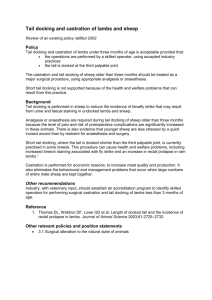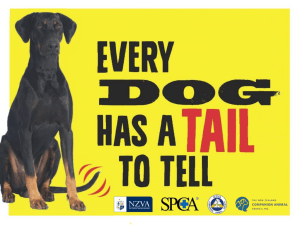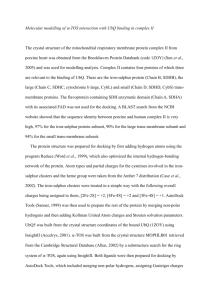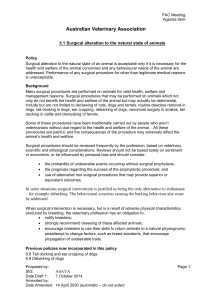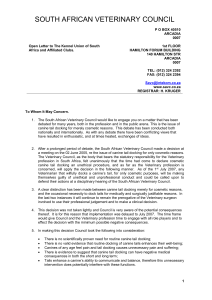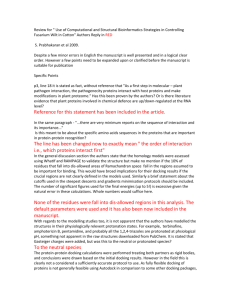Tail Docking arguments
advertisement
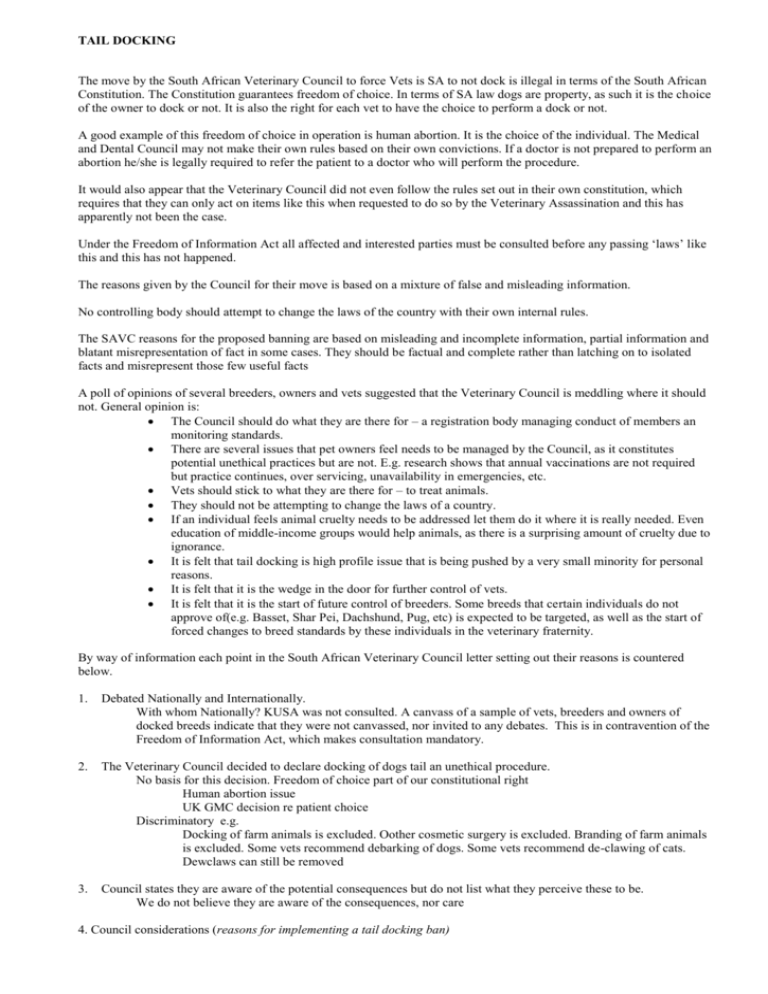
TAIL DOCKING The move by the South African Veterinary Council to force Vets is SA to not dock is illegal in terms of the South African Constitution. The Constitution guarantees freedom of choice. In terms of SA law dogs are property, as such it is the choice of the owner to dock or not. It is also the right for each vet to have the choice to perform a dock or not. A good example of this freedom of choice in operation is human abortion. It is the choice of the individual. The Medical and Dental Council may not make their own rules based on their own convictions. If a doctor is not prepared to perform an abortion he/she is legally required to refer the patient to a doctor who will perform the procedure. It would also appear that the Veterinary Council did not even follow the rules set out in their own constitution, which requires that they can only act on items like this when requested to do so by the Veterinary Assassination and this has apparently not been the case. Under the Freedom of Information Act all affected and interested parties must be consulted before any passing ‘laws’ like this and this has not happened. The reasons given by the Council for their move is based on a mixture of false and misleading information. No controlling body should attempt to change the laws of the country with their own internal rules. The SAVC reasons for the proposed banning are based on misleading and incomplete information, partial information and blatant misrepresentation of fact in some cases. They should be factual and complete rather than latching on to isolated facts and misrepresent those few useful facts A poll of opinions of several breeders, owners and vets suggested that the Veterinary Council is meddling where it should not. General opinion is: The Council should do what they are there for – a registration body managing conduct of members an monitoring standards. There are several issues that pet owners feel needs to be managed by the Council, as it constitutes potential unethical practices but are not. E.g. research shows that annual vaccinations are not required but practice continues, over servicing, unavailability in emergencies, etc. Vets should stick to what they are there for – to treat animals. They should not be attempting to change the laws of a country. If an individual feels animal cruelty needs to be addressed let them do it where it is really needed. Even education of middle-income groups would help animals, as there is a surprising amount of cruelty due to ignorance. It is felt that tail docking is high profile issue that is being pushed by a very small minority for personal reasons. It is felt that it is the wedge in the door for further control of vets. It is felt that it is the start of future control of breeders. Some breeds that certain individuals do not approve of(e.g. Basset, Shar Pei, Dachshund, Pug, etc) is expected to be targeted, as well as the start of forced changes to breed standards by these individuals in the veterinary fraternity. By way of information each point in the South African Veterinary Council letter setting out their reasons is countered below. 1. Debated Nationally and Internationally. With whom Nationally? KUSA was not consulted. A canvass of a sample of vets, breeders and owners of docked breeds indicate that they were not canvassed, nor invited to any debates. This is in contravention of the Freedom of Information Act, which makes consultation mandatory. 2. The Veterinary Council decided to declare docking of dogs tail an unethical procedure. No basis for this decision. Freedom of choice part of our constitutional right Human abortion issue UK GMC decision re patient choice Discriminatory e.g. Docking of farm animals is excluded. Oother cosmetic surgery is excluded. Branding of farm animals is excluded. Some vets recommend debarking of dogs. Some vets recommend de-clawing of cats. Dewclaws can still be removed 3. Council states they are aware of the potential consequences but do not list what they perceive these to be. We do not believe they are aware of the consequences, nor care 4. Council considerations (reasons for implementing a tail docking ban) There is no scientifically proven need for routine canine tail docking; There is no valid evidence that routine docking of canine tails enhances their well-being; Canines of any age feel pain and tail docking causes unnecessary pain and suffering; There is evidence to suggest that canine tail docking can have negative medical consequences in both the short and long term; Tails enhance a canine’s ability to communicate and balance, therefore this unnecessary intervention does potentially interfere with these functions. Answers to above Scientific proof does exist that tail injury is very common in traditionally docked breeds now left with tails, but there is no proof that docking is detrimental. As and example: in some countries working dogs have been specifically excluded as the need to dock their tails have been proven. There is no evidence that it damages the dogs well-being. Adult dogs are sent home the same day when a spay is performed with no more than a long acting anti inflammatory for pain relief. This procedure is comparable to a human hysterectomy, which is extremely painful and requires extensive pain management for days post op and it requires a stay of several days in hospital. Do vets know dogs feel less pain than humans? Pain Perception in puppies was scientifically researched: The nervous system in a newborn is not yet developed enough to feel pain. A quote out of a letter from Prof. Dr. R. Fritsch, Leader of the Clinic of Veterinary Surgeons, Justus-Lieberg-University, to the German Kennel Club. “”Schmidker wrote in his doctorate in 1951 about the feeling of pain in new-born puppies: "Incomplete development of the nervous system at the time of birth and the very high chronaxie value in connection with the fact that the animal is not able to react effectively to pain, gives us every reason to believe that the actual feeling of pain is very low in the new-born of this group of mammals (dogs). In other words, at this age and biological condition, it would have no absolute meaning to talk about pain". You therefore do not have to worry or fear that the dog will be made to suffer pain or psychological pain, if the tail has been docked or the dew claws removed, in the first few days after birth.”” What negative medical consequences in long and short term are suggested in docked breeds? None are know of by the breeders and owners canvassed and certainly have not been scientifically proven. Where is the scientific proof of the suggested communication and balance problems? As an owner and trainer of docked and undocked breeds I have never experienced any problem in their communication, nor with their balance. I have asked the same question of several other long time breeders and owners, all similarly surprised that this is even suggested. There are docked breeds that are known as some of the most agile animals around. There is absolutely no evidence that their balance is affected in any way. A docked pup walks at about the same age as an undocked pup – no balance problems. Seems several of the Veterinary Council’s reasons owe more to anthropomorphic motivation than reality. Vets recommend several very intrusive and severely personality altering procedures Debarking , Spay, Neuter, De-clawing of cats. 5. Pain issue again. False premise. The reverse has been proven in newborns In contrast: The pain of an adult dog that needs surgery to an injured tail is significant. The pain of an injury to the tail for the rest of its life can be significant. 6. Perceived enhancement of breed standards Most dog breeds today are man made. Docked breeds were developed ignoring the tail as it was docked when the pup was a few days old. In consequence most of the tails on docked breeds are a problem if left on. In addition the long tail is not acceptable to most of the owners of these breeds. Is this heading for the control by vets of other breed practices? Dachshund, Shar Pei, Basset, Bulldog? 7. Although it is felt that the SAVC letter was written by people who do not understand docked breeds, have probably never lived with them and that their contention that docking is purely cosmetic is not accurate, it should be considered that cosmetic surgery as such is not an unacceptable practice today, as it was years ago. Cosmetic surgery is an accepted and acceptable fact in today’s society. Medical science has developed to accommodate this human requirement. So why not for dogs that is after all an extension of the human persona far more than they are animals. 8. Sheep docking excluded. Each case evaluated on it’s merit This shows an amazing double standard. Sheep docking is far worse than dog tail docking if looked at from an animal cruelty viewpoint. The animal is more developed at the age when it’s done and it consequently feels more pain. Is the reason for sheep tail docking really valid? Not proven, it is just convention. What about pigs? Too powerful a group to offend? Chicken farming practices should be looked into. Or is it a case of it is OK to be cruel as long as you kill and eat the animal at the end of the day? 9. Ear cropping was mentioned The Council ban on this and the intent to prosecute vets is illegal in terms of or constitution. Maybe the proposers are unaware of why cropping was originally stopped, and of how it is now done. The original reasons for the ban i.e. how it was done no longer valid. 10. International move to do away with docking. Less than 25% of the world does not constitute an international move. In fact, several very large countries (+- 75% of the world) have actively decided that tail docking and ear cropping is acceptable if done by a qualified person. 11. Australia, New Zealand and the UK are quoted as examples of passing anti docking laws. They are a very small part of the world What makes them right and the rest of the world wrong? In fact the UK has not banned docking. UK Parliament recently decided to allow the choice of docking to remain with the breeder/owner. 12. Training not included in Ondersetpoort curriculum Exclusion of a procedure in training at Ondersetpoort is not a reason for banning. Principles are taught, not each individual procedure. The curriculum should be changed if there is a need 13. The threat of prosecution of individuals is out of place and should not even be suggested by the Veterinary Council. Fund available for Animal Anti Cruelty action should go to where it is really needed. M Knight March 2006 For docking information: http://www.cdb.org/link2.htm
